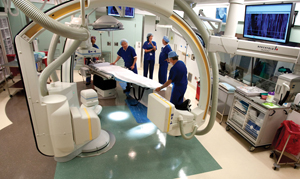September 23, 2010

Stanford Hospital's new hybrid room brings powerful imaging technologies into the operating room as a way to streamline combined specialties in minimally invasive procedures.
As minimally invasive surgical procedures increasingly involve smaller incisions, shorter recovery times and less blood loss, hospitals are being dramatically redesigned to support new techniques and technologies.
"I don't think we're going to hear the words 'operating room' anymore," said Ronald Dalman, MD, chief of vascular surgery at Stanford Hospital & Clinics. "A different terminology will be required, and 'interventional platform' is probably the best we've got to date."
In plans for the rebuilt Stanford Hospital, which is projected to open by the end of the decade, the entire second floor will be configured as an interventional platform. At Lucile Packard Children's Hospital, new surgical and imaging suites will be known collectively as the "diagnostic and treatment center."
"It's the inevitable consequence of continuous miniaturization and remote monitoring," Dalman said. "Basically, all procedures, regardless of who's performing them and where they're being performed, are headed in a similar direction."
Combined expertise
Physicians from four medical specialties that have developed independently-interventional imaging, angiography, cardiac catheterization and surgery-all will work together side by side in these new facilities.
Dalman recalled a recent complex procedure that required collaboration among teams of vascular surgeons and cardiac surgeons, with help from imaging specialists. The case involved a patient with a thoracic aortic aneurysm, a weakness in the aorta, the main blood vessel supplying blood to the body.
Physicians opened the patient's chest, repaired the vessels at the base of the heart, and then inserted an image-guided endograft, a fabric-covered metallic stent. Having specialized imaging technology and diverse experts on hand was critical to the operation, he said.
"It's kind of a metaphor for the new interventional platform, where the operating suite has imaging equipment and the imaging facility works at operating-room standards," Dalman said.
Design process
Dalman is in a group led by George Tingwald, MD, director of medical planning for the hospital renewal project, that is designing the new platform.
"We all came to this idea with our own expectations," Dalman said. "The cardiologists wanted X, and the interventional radiologists wanted Y. All of us have bought into this vision of a single-management paradigm. We now share a single expectation of how procedures are conducted and how patients are checked in and monitored."
He credits Tingwald with recognizing the potential of an interventional platform. "He has a lot of experience with what other hospitals are doing, and when we talk about what we want, he leavens the discussion by saying, 'That was tried and didn't work.'"
Tingwald says hospitals nationwide are facing a new reality: Operating rooms and catheterization labs typically are rebuilt every 20 years, but the procedures performed in them change every two to three years.
"So do you build operating rooms that you know are going to become obsolete? Or do you build additional 'cath' labs because you know those procedures are going to increase? Or do you put them together in a space that allows for flexibility-where future technology can happen?" Tingwald said. "It sounds so simple, but it's a profound change in how we build and operate facilities."
Adaptability and safety
The Packard Children's diagnostic and treatment center will include four new surgical and imaging suites. One will be designed specifically for neurologic cases, and two will house nuclear medicine technologies. There also will be four new rooms that can accommodate interventional radiology technology and catheterization procedures. All of the suites will be at least 600 square feet and will be equipped with voice-activated machines, 52-inch high-definition monitors and videoconferencing capabilities. Imaging systems, including a new MRI, PET scan and image-guided CT, will augment the technologies, which will be continuously updated.
Plans for the adult hospital call for 28 "flexible rooms" of about 1,000 square feet each, in contrast with the 700-square-foot operating rooms in the current configuration. These rooms will be big enough to accommodate endoscopic and imaging equipment, lighting booms and the huge consoles of the da Vinci robotic surgery system.
"The way the platform is designed, every room is identical in terms of size and layout," Dalman said. "That facilitates safety because if there's an emergency, whether you're in room 2 or room 22, everything will be in the same place."
A hybrid room-an operating suite with imaging capability-opened in the hospital this spring. Surgeons and interventional radiologists say it will give them a head start in developing the collaboration that will be required in the future rooms.
"By the time we actually move into the new facility, everyone will be on the same team, working with the same guidelines," Dalman said.
For more information about the plans for the medical center, see the project's Web site at http://stanfordpackard.org.
About Stanford Medicine
Stanford Medicine is an integrated academic health system comprising the Stanford School of Medicine and adult and pediatric health care delivery systems. Together, they harness the full potential of biomedicine through collaborative research, education and clinical care for patients. For more information, please visit med.stanford.edu.